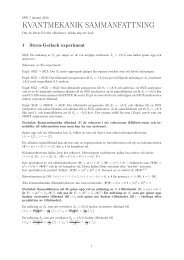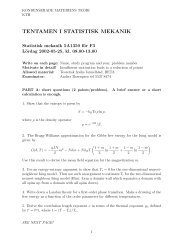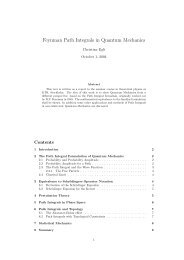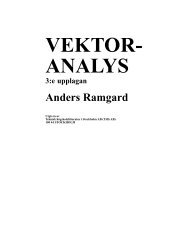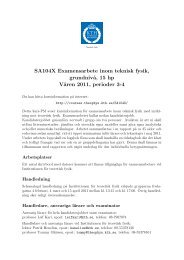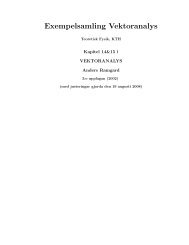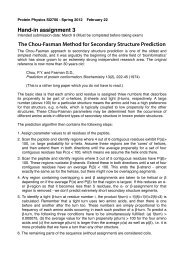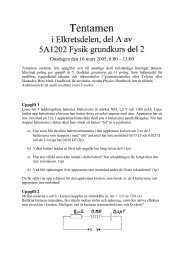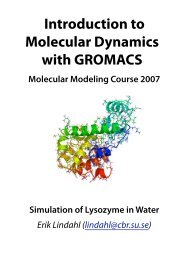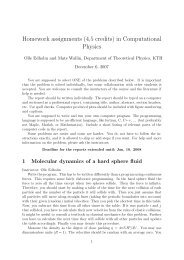[VAR]=Notes on variational calculus
[VAR]=Notes on variational calculus
[VAR]=Notes on variational calculus
Create successful ePaper yourself
Turn your PDF publications into a flip-book with our unique Google optimized e-Paper software.
eing extremal: the extremal points x = x λ will depend <strong>on</strong> λ, and the value of λ is<br />
then to be fixed so that g(x λ ) = g 0 . The paramter λ introduced here is often called<br />
Lagrange multiplier.<br />
To summarize: The problem “extremize the functi<strong>on</strong> f <strong>on</strong> R N with the c<strong>on</strong>straint<br />
that another functi<strong>on</strong> g <strong>on</strong> R N has a fixed given value g 0 ” is equivalent to “extremize<br />
the functi<strong>on</strong> f − λg <strong>on</strong> R N and determine the parameter λ so that the extremal point<br />
fulfills the c<strong>on</strong>straint.”<br />
This argument can be generalized to functi<strong>on</strong>als and used to derive the following<br />
Fact G: Problem G above is equivalent to extremizing the functi<strong>on</strong>al<br />
J[u] − λK[u] (42)<br />
and then determining the parameter λ so that the c<strong>on</strong>straint K[u] = K 0 is fulfilled: To<br />
solve Problem G <strong>on</strong>e solves the Euler-Lagrange equati<strong>on</strong>s<br />
∂(F − λG)<br />
∂u(x)<br />
− d ∂(F − λG)<br />
= 0 (43)<br />
dx ∂u ′ (x)<br />
(which has soluti<strong>on</strong>s u depending <strong>on</strong> the parameter λ, of course) and then fixing λ by<br />
the c<strong>on</strong>straint.<br />
It is easy to generalize this method to other kinds of functi<strong>on</strong>s and/or to variati<strong>on</strong>al<br />
problems with several c<strong>on</strong>straints given by functi<strong>on</strong>al: Minimizing any kind of functi<strong>on</strong>al<br />
J[u] with c<strong>on</strong>straints K J [u] = k J , J = 1, 2, . . ., L, is equivalent to minimizing<br />
J[u] −<br />
L∑<br />
λ J K J [u] (44)<br />
J=1<br />
and then fixing the parameters λ J so that all c<strong>on</strong>straints are fulfilled: The soluti<strong>on</strong>s<br />
of the Euler-Lagrange equati<strong>on</strong>s which amount to minimizing the functi<strong>on</strong>al in (44)<br />
will depend <strong>on</strong> the parameters λ 1 , λ 2 , . . .,λ L , and this is exactly the number of free<br />
parameters needed to fulfill the L c<strong>on</strong>straints. Again I leave details to the interested<br />
reader.<br />
2.5 Variati<strong>on</strong>al problems with higher derivatives.<br />
I finally shortly discuss variati<strong>on</strong>al problems involving higher derivatives and leading<br />
to higher order differential equati<strong>on</strong>s. For simplicity I <strong>on</strong>ly c<strong>on</strong>sider such problems for<br />
real-valued functi<strong>on</strong>s u of <strong>on</strong>e real variable — the generalizati<strong>on</strong> to other cases is<br />
straightforward: We c<strong>on</strong>sider a functi<strong>on</strong>al<br />
J[u] =<br />
∫ x1<br />
x 0<br />
F(u(x), u ′ (x), u ′′ (x), x)dx (45)<br />
16


![[VAR]=Notes on variational calculus](https://img.yumpu.com/35639168/16/500x640/varnotes-on-variational-calculus.jpg)
